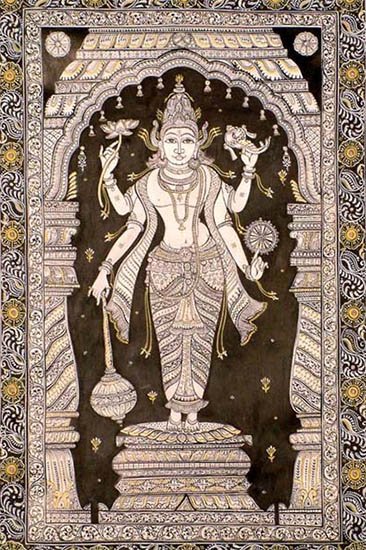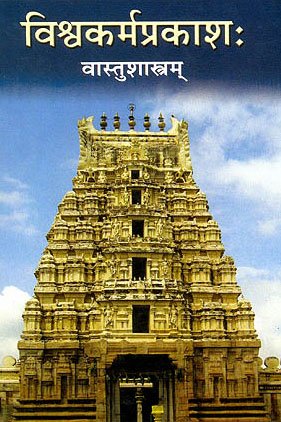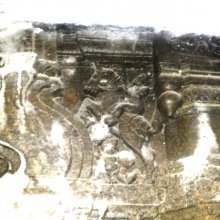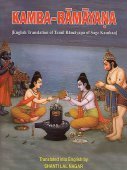Hiranya, Hiraṇya, Hiraṇyā: 28 definitions
Introduction:
Hiranya means something in Buddhism, Pali, Hinduism, Sanskrit, Jainism, Prakrit, the history of ancient India, Marathi, Hindi. If you want to know the exact meaning, history, etymology or English translation of this term then check out the descriptions on this page. Add your comment or reference to a book if you want to contribute to this summary article.
Alternative spellings of this word include Hirany.
Images (photo gallery)
In Hinduism
Shaivism (Shaiva philosophy)
Source: Wisdom Library: Kubjikāmata-tantra1) Hiraṇyā (हिरण्या, “gold”):—One of the nine Dūtī presided over by one of the nine bhaivaravas named Yogeśa (emanation of Ananta, who is the central presiding deity of Dūtīcakra), according to the Kubjikāmata-tantra and the Ṣaṭsāhasrasaṃhitā.
2) Hiraṇyā (हिरण्या, “gold”):—One of the nine Dūtī presided over by one of the nine bhaivaravas named Hāṭakeśa (emanation of Ananta, who is the central presiding deity of Dūtīcakra), according to the Kubjikāmata-tantra and the Ṣaṭsāhasrasaṃhitā.
Source: Wisdom Library: ŚaivismHiraṇya (हिरण्य) is the name of a daitya chief, presiding over Mahātala, according to the Parākhyatantra 5.44-45. Mahātala refers to one of the seven pātālas (‘subterranean paradise’). The word pātāla in this tantra refers to subterranean paradises for seekers of otherworldly pleasures and each the seven pātālas is occupied by a regent of the daityas, nāgas and rākṣasas.
The Parākhyatantra is an old Śaiva-siddhānta tantra dating from before the 10th century.
Source: Manblunder: Sri Rudram 2.1-2Hiraṇya (हिरण्य) means gold. There are several references to hiraṇya. His (Rudra) body is shining as Shiva is always described as Prakāśa or Self-effulgent. Secondly, hiraṇya always refers to imperishable matter, which subtle conveys that is He is beyond time (kāla). Attributes of Rudra are being worshiped now.

Shaiva (शैव, śaiva) or Shaivism (śaivism) represents a tradition of Hinduism worshiping Shiva as the supreme being. Closely related to Shaktism, Shaiva literature includes a range of scriptures, including Tantras, while the root of this tradition may be traced back to the ancient Vedas.
Purana and Itihasa (epic history)
Source: archive.org: Puranic EncyclopediaHiraṇya (हिरण्य).—(Hiraṇyakaśipu, Hiraṇyākṣa) General. Owing to a curse Jaya and Vijaya who were gate-keepers at Vaikuṇṭha were born as two asuras, Hiraṇyākṣa (elder brother) and Hiraṇyakaśipu (younger brother). These brothers are known also as the Hiraṇyas. (See Jayavijayas). (See full article at Story of Hiraṇya from the Puranic encyclopaedia by Vettam Mani)
Source: archive.org: Shiva Purana - English TranslationHiraṇya (हिरण्य) refers to the “golden one” and is used to describe Śiva, according the Śivapurāṇa 2.2.41.—Accordingly, as Viṣṇu and others eulogized Śiva:—“[...] obeisance to the golden one (i.e., hiraṇya), the great lord, of golden body; obeisance to Bhīma, Bhīmarūpa, obeisance to one engaged in terrible deeds. Obeisance to one who has smeared his body with ashes, decorated himself with Rudrākṣa; and is of short long dwarfish height”.
Source: Cologne Digital Sanskrit Dictionaries: The Purana IndexHiraṇya (हिरण्य).—Cash in gold; the best gift.*
- * Matsya-purāṇa 34. 11; 55. 19; Viṣṇu-purāṇa IV. 10. 24.

The Purana (पुराण, purāṇas) refers to Sanskrit literature preserving ancient India’s vast cultural history, including historical legends, religious ceremonies, various arts and sciences. The eighteen mahapuranas total over 400,000 shlokas (metrical couplets) and date to at least several centuries BCE.
Shilpashastra (iconography)
Source: archive.org: Pratima Kosa Encyclopedia of Indian Iconography - Vol 6Hiraṇya (हिरण्य) refers to one of the many varieties of the Śālagrāma (ammonite fossil stones).—The Hiraṇya is moon-shaped; whitish hue and golden lines. Śālagrāma stones are very ancient geological specimens, rendered rounded and smooth by water-currents in a great length of time. They (e.g., Hiraṇya stones) are distinguished by the ammonite (śālā, described as “vajra-kīṭa”, “adamantine worms”) which having entered into them for residence, are fossilized in course of time, leaving discus-like marks inside the stone.

Shilpashastra (शिल्पशास्त्र, śilpaśāstra) represents the ancient Indian science (shastra) of creative arts (shilpa) such as sculpture, iconography and painting. Closely related to Vastushastra (architecture), they often share the same literature.
Kavya (poetry)
Source: Wisdom Library: KathāsaritsāgaraHiraṇya (हिरण्य) is the name of a mouse (mūṣaka), according to the Kathāsaritsāgara, chapter 61. Accordingly, as Gomukha said to Naravāhanadatta: “... then Citragrīva, being relieved from his fear, said to his followers: ‘Let us quickly go to my friend the mouse Hiraṇya; he will gnaw these meshes asunder and set us at liberty’”.
The Kathāsaritsāgara (‘ocean of streams of story’), mentioning Hiraṇya, is a famous Sanskrit epic story revolving around prince Naravāhanadatta and his quest to become the emperor of the vidyādharas (celestial beings). The work is said to have been an adaptation of Guṇāḍhya’s Bṛhatkathā consisting of 100,000 verses, which in turn is part of a larger work containing 700,000 verses.

Kavya (काव्य, kavya) refers to Sanskrit poetry, a popular ancient Indian tradition of literature. There have been many Sanskrit poets over the ages, hailing from ancient India and beyond. This topic includes mahakavya, or ‘epic poetry’ and natya, or ‘dramatic poetry’.
Jyotisha (astronomy and astrology)
Source: Wisdom Library: Brihat Samhita by VarahamihiraHiraṇya (हिरण्य) refers to “gold”, according to the Bṛhatsaṃhitā (chapter 5), an encyclopedic Sanskrit work written by Varāhamihira mainly focusing on the science of ancient Indian astronomy astronomy (Jyotiṣa).—Accordingly, “If there should be both lunar and solar eclipses in one month, princes will suffer both from dissensions among their own army and from wars. [...] If the eclipses should fall in the lunar month of Caitra painters, writers, singers, prostitutes, men learned in the Vedas and dealers in gold [i.e., hiraṇya-paṇya], the people of Pauṇḍra, of Auḍra, of Kekaya and of Āśmaka will suffer distress and there will be good rain throughout the land”.

Jyotisha (ज्योतिष, jyotiṣa or jyotish) refers to ‘astronomy’ or “Vedic astrology” and represents the fifth of the six Vedangas (additional sciences to be studied along with the Vedas). Jyotisha concerns itself with the study and prediction of the movements of celestial bodies, in order to calculate the auspicious time for rituals and ceremonies.
Vastushastra (architecture)
Source: Brill: Śaivism and the Tantric Traditions (architecture)Hiraṇya (हिरण्य) refers to “gold”, according to the Devyāmata (chapter 105).—Accordingly, [while describing the layout of the residence (gṛha) for the prāsādāśramin]—“[...] Storage for gems, gold (hiraṇya) and cloths is recommended in the east, and for water in the south and centre. Grain storage is recommended in the west. In the northwest is storage for the mortar. [...]”.

Vastushastra (वास्तुशास्त्र, vāstuśāstra) refers to the ancient Indian science (shastra) of architecture (vastu), dealing with topics such architecture, sculpture, town-building, fort building and various other constructions. Vastu also deals with the philosophy of the architectural relation with the cosmic universe.
General definition (in Hinduism)
Source: archive.org: Vedic index of Names and SubjectsHiraṇya (हिरण्य) in the Rigveda and later denotes ‘gold’. It is hardly possible to exaggerate the value attached to gold by the Vedic Indians. The metal was, it is clear, won from the bed of rivers. Hence the Indus is called ‘golden’ and ‘of golden stream’. Apparently the extraction of gold from the earth was known, and washing for gold is also recorded.
In Buddhism
Tibetan Buddhism (Vajrayana or tantric Buddhism)
Source: Brill: Śaivism and the Tantric Traditions (tantric Buddhism)Hiraṇya (हिरण्य) refers to “gold”, according to Kuladatta’s Kriyāsaṃgrahapañjikā, a text within Tantric Buddhism representing a construction manual for monasteries.—Accordingly, [while describing pratiṣṭhā in chapter 4]—“Then the king should satisfy the architects, the assistants, and the spectators with a bracelet, a finger-ring, a garment, gold (hiraṇya), heap of chaplet, tāmbūla, or other [articles] according to [the donor’s] wealth”.

Tibetan Buddhism includes schools such as Nyingma, Kadampa, Kagyu and Gelug. Their primary canon of literature is divided in two broad categories: The Kangyur, which consists of Buddha’s words, and the Tengyur, which includes commentaries from various sources. Esotericism and tantra techniques (vajrayāna) are collected indepently.
In Jainism
General definition (in Jainism)
Source: archive.org: Jaina YogaHiraṇya (हिरण्य) according to Śvetāmabara sources refers to “silver” while according to Digambara it refers to “gold coins”. It represents one of the classes of the external (bahya) division of attachment (parigraha) and is related to the Aparigraha-vrata (vow of non-attachment). Hiraṇya is listed in Śvetāmbara sources such as Devagupta’s Nava-pada-prakaraṇa with Laghu-vṛtti (58), and in Digambara sources such Cāmuṇḍarāya’s Caritrasāra (p. 7).
The unanimous testimony of the Śvetāmbara texts interprets hiraṇya as “silver, minted or unminted” and, in fact, the later works from Devendra’s Śrādha-dina-kṛtya onwards replace hiraṇya by less ambiguous terms. For the Digambara deary as it seems always to have meant “coins whether of gold or silver”.

Jainism is an Indian religion of Dharma whose doctrine revolves around harmlessness (ahimsa) towards every living being. The two major branches (Digambara and Svetambara) of Jainism stimulate self-control (or, shramana, ‘self-reliance’) and spiritual development through a path of peace for the soul to progess to the ultimate goal.
India history and geography
Source: archive.org: Nilamata Purana: a cultural and literary study (history)Hiraṇyā (हिरण्या) is the name of a river mentioned in the Nīlamatapurāṇa. Hiraṇyā is another name of Kanakavāhinī.
Source: Cologne Digital Sanskrit Dictionaries: Indian Epigraphical GlossaryHiraṇya.—(IE 8-5; EI 12, 28, 29), same as hiraṇy-āya, hiraṇya- deya; tax payable to the king in cash; dues payable in coins; cash; sometimes abbreviated as hi as in sāṃ-hi = sāṃvatsarika- hiraṇya, annual revenue income in cash; cf. a-hiraṇya-dhānya- praṇaya-pradeya (IE 8-5); it may be in addition to the tax in grain or in lieu of the latter. Cf. Tamil kāś-āya, etc. (HRS), king's share of certain crops paid in cash. (CII 1), probably, ‘money’. Note: hiraṇya is defined in the “Indian epigraphical glossary” as it can be found on ancient inscriptions commonly written in Sanskrit, Prakrit or Dravidian languages.

The history of India traces the identification of countries, villages, towns and other regions of India, as well as mythology, zoology, royal dynasties, rulers, tribes, local festivities and traditions and regional languages. Ancient India enjoyed religious freedom and encourages the path of Dharma, a concept common to Buddhism, Hinduism, and Jainism.
Languages of India and abroad
Marathi-English dictionary
Source: DDSA: The Molesworth Marathi and English Dictionaryhiraṇya (हिरण्य).—n S Gold.
Source: DDSA: The Aryabhusan school dictionary, Marathi-Englishhiraṇya (हिरण्य).—n Gold.
Marathi is an Indo-European language having over 70 million native speakers people in (predominantly) Maharashtra India. Marathi, like many other Indo-Aryan languages, evolved from early forms of Prakrit, which itself is a subset of Sanskrit, one of the most ancient languages of the world.
Sanskrit dictionary
Source: DDSA: The practical Sanskrit-English dictionaryHiraṇya (हिरण्य).—[hiraṇameva svārthe yat]
1) Gold; Manusmṛti 2.246.
2) Any vessel of gold; मन्त्रवत् प्राशनं चास्य हिरण्यमधुसर्पिषाम् (mantravat prāśanaṃ cāsya hiraṇyamadhusarpiṣām) Manusmṛti 2.29 (some take in the first sense).
3) Silver; (dadau) हिरण्यस्य सुवर्णस्य मुक्तानां विद्रुमस्य च (hiraṇyasya suvarṇasya muktānāṃ vidrumasya ca) Rām.1.74.5; Mahābhārata (Bombay) 13.57.34.
4) Any precious metal.
5) Wealth, property; अपदेश्यैश्च संन्यस्य हिरण्यं तस्य तत्त्वतः (apadeśyaiśca saṃnyasya hiraṇyaṃ tasya tattvataḥ) Manusmṛti 8.182.
6) Semen virile.
7) A cowrie.
8) particular measure.
9) A substance.
1) The thorn-apple (dhattūra).
-ṇyā One of the seven tongues of fire.
Derivable forms: hiraṇyam (हिरण्यम्).
Source: Cologne Digital Sanskrit Dictionaries: Shabda-Sagara Sanskrit-English DictionaryHiraṇya (हिरण्य).—n. (-ṇya) 1. Gold. 2. Either of the precious metals, crude bullion, unwrought gold or silver. 3. Silver, crude or wrought. 4. Any precious metal. 5. A measure. 6. A cowrie. 7. Semen virile. 8. Imperishable matter, that which is eternal. 9. Thing, substance. 10. Wealth, property. 11. The Dhattura plant. E. hṛ to take, Unadi aff. kanyan, and kirac substituted for the radical letters; or hiraṇa, yat aff.
Source: Cologne Digital Sanskrit Dictionaries: Benfey Sanskrit-English DictionaryHiraṇya (हिरण्य).—probably hiraṇa + [Pagē115-b+ 38] ya, n. 1. Gold, [Pañcatantra] iii. [distich] 15; [Mānavadharmaśāstra] 2, 29 (a golden spoon). 2. Silver. 3. Wealth. 4. A cowry (a small coin). 5. Substance. 6. Imperishable matter 7. Semen virile.
Source: Cologne Digital Sanskrit Dictionaries: Cappeller Sanskrit-English DictionaryHiraṇya (हिरण्य).—[neuter] gold, a gold coin or ornament; any precious metal, money.
Source: Cologne Digital Sanskrit Dictionaries: Aufrecht Catalogus CatalogorumHiraṇya (हिरण्य) as mentioned in Aufrecht’s Catalogus Catalogorum:—father of Śiva, father of Jñāna, father of Durgādāsa, father of Gopāla (Gītagovindaṭīkā 1678). L. 2229.
Source: Cologne Digital Sanskrit Dictionaries: Monier-Williams Sanskrit-English Dictionary1) Hiraṇya (हिरण्य):—[from hiraṇa] n. (ifc. f(ā). ; [probably] connected with hari, harit, hiri) gold ([originally] ‘uncoined gold or other precious metal’; in later language ‘coined gold’ -or ‘money’), [Ṛg-veda] etc. etc.
2) [v.s. ...] any vessel or ornament made of gold (as ‘a golden spoon’ [Manu-smṛti ii, 29]), [Ṛg-veda; Atharva-veda; Vājasaneyi-saṃhitā; Kauśika-sūtra]
3) [v.s. ...] a gold piece or coin (generally with suvarṇa as opp. to base metal), [Brāhmaṇa]
4) [v.s. ...] a cowry, [cf. Lexicographers, esp. such as amarasiṃha, halāyudha, hemacandra, etc.]
5) [v.s. ...] semen virile, [cf. Lexicographers, esp. such as amarasiṃha, halāyudha, hemacandra, etc.]
6) [v.s. ...] substance, imperishable matter, [cf. Lexicographers, esp. such as amarasiṃha, halāyudha, hemacandra, etc.]
7) [v.s. ...] a [particular] measure, [Horace H. Wilson]
8) [v.s. ...] the Datura or thorn apple, [Monier-Williams’ Sanskrit-English Dictionary]
9) [v.s. ...] Name of a Varṣa (= hiraṇ-maya), [Mārkaṇḍeya-purāṇa]
10) [v.s. ...] m. a kind of bdellium, [cf. Lexicographers, esp. such as amarasiṃha, halāyudha, hemacandra, etc.]
11) [v.s. ...] Name of a, Daitya, [Mahābhārata; Pañcarātra]
12) [v.s. ...] of a son of Agnīdhra (= hiraṇ-maya q.v.), [Mārkaṇḍeya-purāṇa]
13) [v.s. ...] of a king of Kaśmīra, [Rājataraṅgiṇī]
14) Hiraṇyā (हिरण्या):—[from hiraṇya > hiraṇa] f. one of the seven tongues of fire, [cf. Lexicographers, esp. such as amarasiṃha, halāyudha, hemacandra, etc.]
15) Hiraṇya (हिरण्य):—[from hiraṇa] mfn. golden, made of gold, [Manu-smṛti; Mahābhārata]
Source: Cologne Digital Sanskrit Dictionaries: Yates Sanskrit-English Dictionary1) Hiraṇya (हिरण्य):—(ṇyaṃ) 1. n. Gold; silver; wealth; semen virile; a cowry; thing, substance; imperishable matter.
2) kaśipu (puḥ) 2. m. A Daitya whom Krishna destroyed in his fourth or human incarnation.
Source: DDSA: Paia-sadda-mahannavo; a comprehensive Prakrit Hindi dictionary (S)Hiraṇya (हिरण्य) in the Sanskrit language is related to the Prakrit words: Hiraṇṇa, Hiranna.
[Sanskrit to German]
Sanskrit, also spelled संस्कृतम् (saṃskṛtam), is an ancient language of India commonly seen as the grandmother of the Indo-European language family (even English!). Closely allied with Prakrit and Pali, Sanskrit is more exhaustive in both grammar and terms and has the most extensive collection of literature in the world, greatly surpassing its sister-languages Greek and Latin.
Hindi dictionary
Source: DDSA: A practical Hindi-English dictionaryHiraṇya (हिरण्य) [Also spelled hirany]:—(nm) gold; ~[garbha] an epithet of Brahma:, mythologically born of a gold egg.
...
Kannada-English dictionary
Source: Alar: Kannada-English corpusHiraṇya (ಹಿರಣ್ಯ):—
1) [noun] gold.
2) [noun] a container, vessel made of gold.
3) [noun] silver.
4) [noun] any precious metal.
5) [noun] riches; wealth.
6) [noun] the viscid, whitish fluid produced in the male reproductive organs, containing spermatozoa; the semen.
7) [noun] the glossy shell of any of number of gastropods; a cowrie.
8) [noun] the seed capsule of Datura stramonium.
9) [noun] a gold coin.
10) [noun] name of one of the seven flames of a fire.
Kannada is a Dravidian language (as opposed to the Indo-European language family) mainly spoken in the southwestern region of India.
See also (Relevant definitions)
Starts with (+187): Hiranya-deya, Hiranya-tuttha, Hiranyabaha, Hiranyabahu, Hiranyabandhana, Hiranyabha, Hiranyabhishu, Hiranyabindu, Hiranyabja, Hiranyacakra, Hiranyada, Hiranyadakshina, Hiranyadamshtra, Hiranyadana, Hiranyadani, Hiranyadant, Hiranyadanta, Hiranyadatta, Hiranyadevisukta, Hiranyadhanus.
Ends with: Ahiranya, Bahuhiranya, Bhiranya, Dhanya-hiranya, Gohiranya, Sahiranya, Samvatsarika-hiranya, Suhiranya.
Full-text (+300): Hiranyaksha, Hiranyavarna, Hiranyagarbha, Hiranyam, Hiranyakashipuhan, Hiranyabahu, Hiranyakeshin, Hiranyada, Hiranyakaksha, Nikasham, Hiranyavaha, Hiranyanabha, Hiranyaretas, Hiranya-tuttha, Hiranyava, Hirana, Hiranyakashipu, Hairanyika, Iraniyan, Hiranyasamdrish.
Relevant text
Search found 85 books and stories containing Hiranya, Hiraṇya, Hiraṇyā; (plurals include: Hiranyas, Hiraṇyas, Hiraṇyās). You can also click to the full overview containing English textual excerpts. Below are direct links for the most relevant articles:
Rig Veda (translation and commentary) (by H. H. Wilson)
Manusmriti with the Commentary of Medhatithi (by Ganganatha Jha)
Verse 8.155 < [Section XXVII - Limitation of Interest (kusīdavṛddhi)]
Verse 4.189 < [Section XIV - Other Duties]
Verse 10.114 < [Section XIII - The Brāhmaṇa in Times of Distress]
Vakyapadiya of Bhartrihari (by K. A. Subramania Iyer)
Verse 3.7.27 < [Book 3 - Pada-kāṇḍa (7): Sādhana-samuddeśa (On the Means)]
Women in the Atharva-veda Samhita (by Pranab Jyoti Kalita)
2. Hymns to Obtain a Husband < [Chapter 2 - The Strīkarmāṇi Hymns of the Atharvaveda]
18. Goddess Pṛthivī < [Chapter 4 - Female Deities and the Glorification of Women in the Atharvaveda]
5. Goddess Āpaḥ (Āpas) < [Chapter 4 - Female Deities and the Glorification of Women in the Atharvaveda]
Tiruvaymoli (Thiruvaimozhi): English translation (by S. Satyamurthi Ayyangar)
Pasuram 4.8.7 < [Section 8 - Eighth Tiruvaymoli (Eru alum Iraiyonum)]
Pasuram 2.8.9 < [Section 8 - Eighth Tiruvaymoli (Anaivatu Aravu-anaimel)]
Pasuram 7.4.6 < [Section 4 - Fourth Tiruvaymoli (Ali ela)]
Puranic encyclopaedia (by Vettam Mani)
Related products

